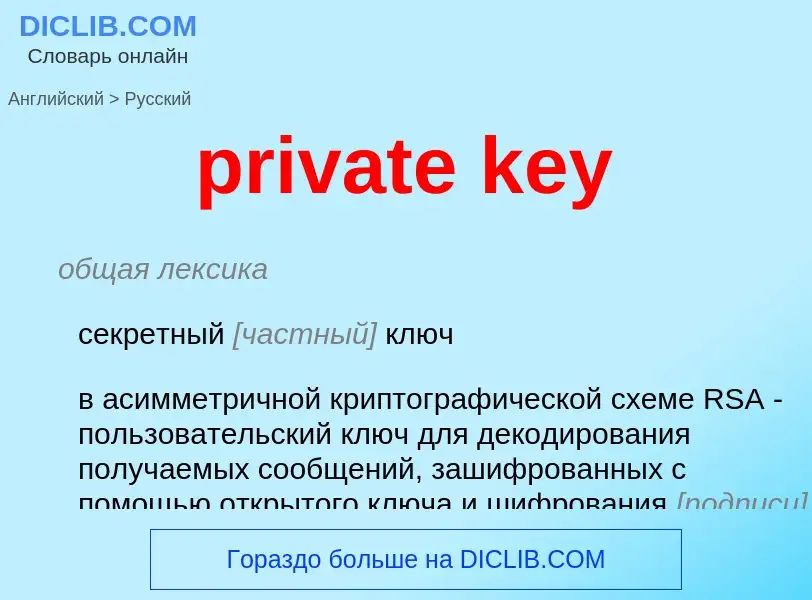Перевод и анализ слов искусственным интеллектом ChatGPT
На этой странице Вы можете получить подробный анализ слова или словосочетания, произведенный с помощью лучшей на сегодняшний день технологии искусственного интеллекта:
- как употребляется слово
- частота употребления
- используется оно чаще в устной или письменной речи
- варианты перевода слова
- примеры употребления (несколько фраз с переводом)
- этимология
private key - перевод на Английский
общая лексика
секретный [частный] ключ
в асимметричной криптографической схеме RSA - пользовательский ключ для декодирования получаемых сообщений, зашифрованных с помощью открытого ключа и шифрования [подписи] исходящих сообщений
антоним
Смотрите также
Определение
Википедия
Public-key cryptography, or asymmetric cryptography, is the field of cryptographic systems that use pairs of related keys. Each key pair consists of a public key and a corresponding private key. Key pairs are generated with cryptographic algorithms based on mathematical problems termed one-way functions. Security of public-key cryptography depends on keeping the private key secret; the public key can be openly distributed without compromising security.
In a public-key encryption system, anyone with a public key can encrypt a message, yielding a ciphertext, but only those who know the corresponding private key can decrypt the ciphertext to obtain the original message.
For example, a journalist can publish the public key of an encryption key pair on a web site so that sources can send secret messages to the news organization in ciphertext. Only the journalist who knows the corresponding private key can decrypt the ciphertexts to obtain the sources' messages—an eavesdropper reading email on its way to the journalist cannot decrypt the ciphertexts. However, public-key encryption does not conceal metadata like what computer a source used to send a message, when they sent it, or how long it is. Public-key encryption on its own also does not tell the recipient anything about who sent a message—it just conceals the content of a message in a ciphertext that can only be decrypted with the private key.
In a digital signature system, a sender can use a private key together with a message to create a signature. Anyone with the corresponding public key can verify whether the signature matches the message, but a forger who does not know the private key cannot find any message/signature pair that will pass verification with the public key.
For example, a software publisher can create a signature key pair and include the public key in software installed on computers. Later, the publisher can distribute an update to the software signed using the private key, and any computer receiving an update can confirm it is genuine by verifying the signature using the public key. As long as the software publisher keeps the private key secret, even if a forger can distribute malicious updates to computers, they cannot convince the computers that any malicious updates are genuine.
Public key algorithms are fundamental security primitives in modern cryptosystems, including applications and protocols which offer assurance of the confidentiality, authenticity and non-repudiability of electronic communications and data storage. They underpin numerous Internet standards, such as Transport Layer Security (TLS), SSH, S/MIME and PGP. Some public key algorithms provide key distribution and secrecy (e.g., Diffie–Hellman key exchange), some provide digital signatures (e.g., Digital Signature Algorithm), and some provide both (e.g., RSA). Compared to symmetric encryption, asymmetric encryption is rather slower than good symmetric encryption, too slow for many purposes. Today's cryptosystems (such as TLS, Secure Shell) use both symmetric encryption and asymmetric encryption, often by using asymmetric encryption to securely exchange a secret key which is then used for symmetric encryption.


